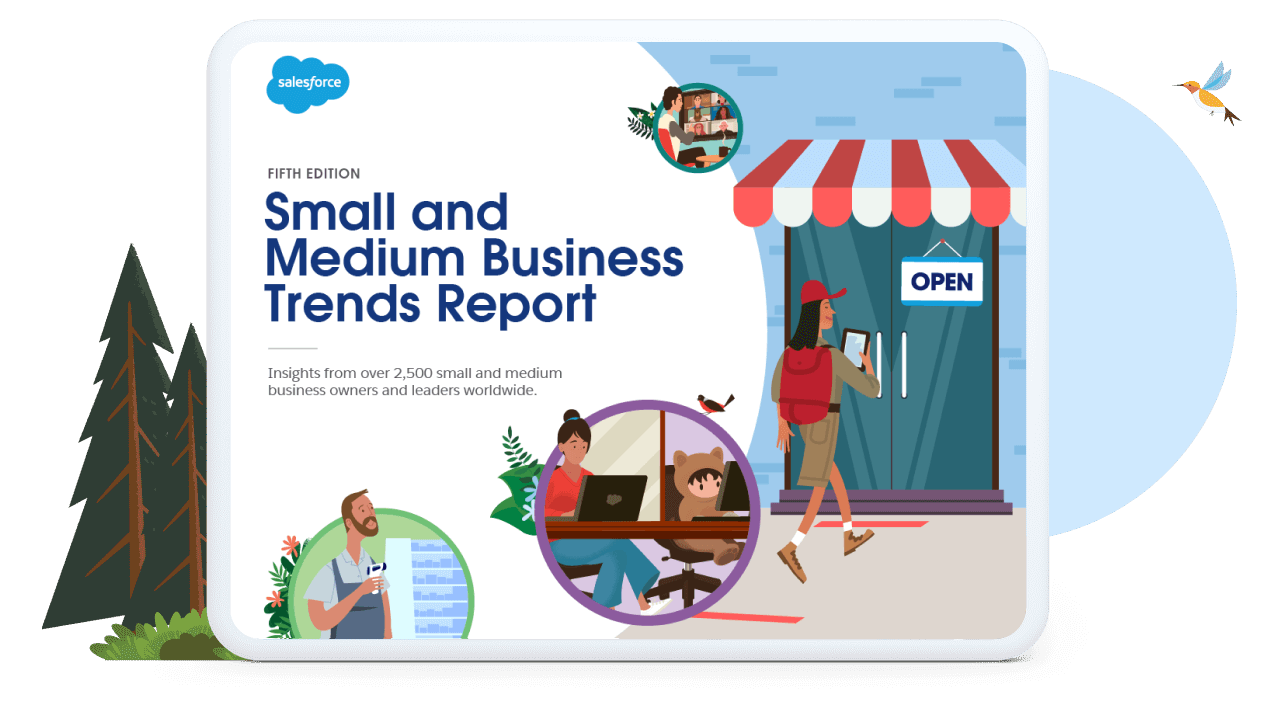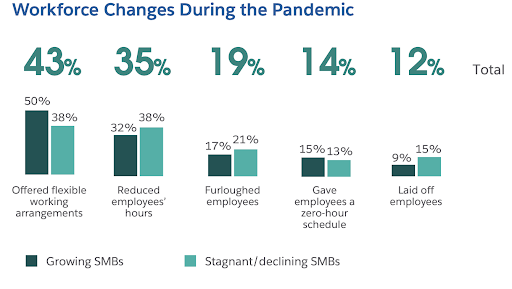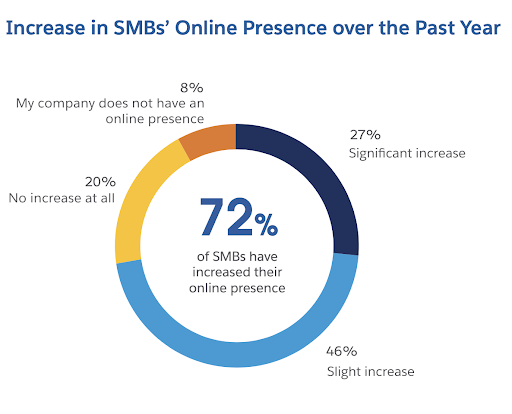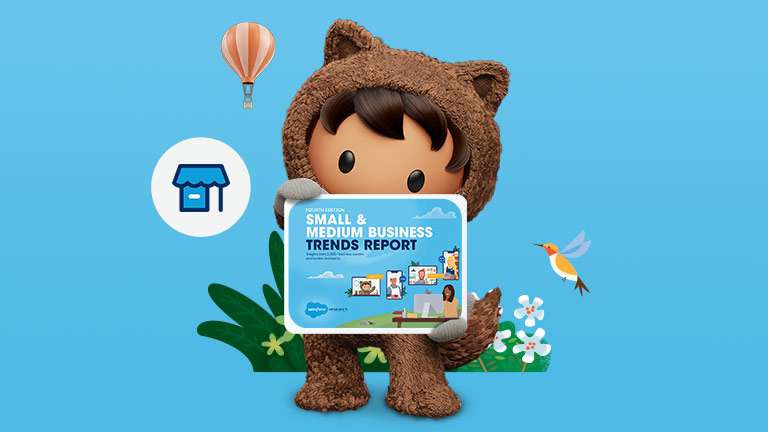Small business trends have always provided an exciting look at where commerce is heading, but they’ve never been as revealing as they are now. Much has changed over the past year, and the pre-pandemic ways of doing business are forever in the rear-view.
To survive, today’s SMEs must be flexible and resilient. To thrive, they need to be digitally empowered and customer-centric. And, even if businesses tick off those boxes, they still might have problems retaining workers in the face of ‘The Great Resignation’.
In other words, small business trends reveal a world on the precipice of something unique. And while business transformation will present some growing pains for many SMEs, it also promises a faster, more innovative and better-connected future.
To precisely determine what that future might look like, we complied insights from 2,500+ SME leaders in The Small and Medium Business Trends Report. Let’s take a look under the bonnet of the small business trends report to discover what’s driving SMEs to new places.
Small business trends put the workforce in the spotlight
Lockdown measures across the EU radically reshaped how we work. Some digitally mature SMEs were able to adapt and pivot fairly quickly, becoming more future-proof in the process. Others struggled to keep remote workforces aligned and provide them with the tools required for success. Some businesses even had to furlough or lay off employees.
The small business trends report shows:
More than two in five SMEs offered flexible working during the pandemic.
Half of growing SMEs (50%) offered flexible working arrangements, vs only 38% of stagnant/declining SMEs.
Flexible scheduling has now become the top employee expectation, while the ability to work remotely ranks fifth.
The report also shows an increased focus on employee wellbeing. Over half (51%) of SME leaders say they’re building trust with their employees by being more transparent with their communications. Similar sentiment has driven 27% of SME leaders to try and connect employees’ passions with their daily work. Additionally, 30% of leaders are building trust with the workforce by offering more autonomy.
This is not too surprising. One of the best ways for small businesses to drive productivity is to create a happy workforce, and productivity has been one of the critical concerns for decentralised teams. By prioritising flexibility and creating a work-from-anywhere workplace, SMEs are building better relationships with employees. And better relationships will often be longer-lasting relationships.
Customer expectations have permanently shifted
There’s no denying that we’re now in a digital-first world. What this might mean for the traditional high street remains to be seen, but for SMEs, the meaning is clear: adapt or fall behind.
Today’s customer expects lightning-fast service. They expect personalised communications. And they expect companies to understand their individual pain points and needs.
The small business trends report reveals that:
More than seven in 10 SME leaders say that their customers expect online transactions.
More than eight in 10 customers (83%) expect to engage with someone immediately when contacting a business.
83% of SMEs have some of their operations online.
72% of SMEs have increased their online presence in the past year.
Most companies seem to be successfully digitising their operations and moving towards e-commerce. The small business trends report shows that 63 % of SMEs now have e-commerce, and a further 14% plan to introduce e-commerce in the next 12 months. But digital experiences aren’t the only things that today’s customers are paying more attention to. They’re also focusing on a brand’s values.
Business-community relationships are becoming less transactional
A Forbes story revealed that consumers are up to six times more likely to support purpose-driven companies. And the small business trends report shows that 90% of customers say that how a company acts during a crisis demonstrates how trustworthy it is. On top of that, the State of the Connected Customer report shows that 68% of customers expect brands to demonstrate empathy, but only 37% say that brands generally do.
The new consumer is looking beyond mere transactions to build more meaningful relationships. They desire empathetic messaging. They care about ethical business practices and healthy work environments. And they want businesses to prioritise sustainability. In other words, they’re focusing on purpose-driven commerce.
And when SMEs show up for their customers, their customers show up for them. The small business trends report reveals that 67% of SME leaders say that community support has been essential for their company’s survival during the pandemic.
Tech is turning old-school businesses into digital powerhouses
Some of the most impactful small business trends revolve around the implementation of new tools and the acceleration of digital transformation projects. Companies that weren’t technologically equipped to pivot in the face of lockdown had to adjust quickly. And many businesses that were already digitally mature doubled down on their tech investment.
According to the small business trends report:
More than half of growing SMEs increased investment in sales and service technology.
31% added e-commerce in the past year.
67% of growing SMEs now have a CRM system.
78% of growing SMEs either already use project or task collaboration tools or plan to in the next 12 months.
When you add the usage of on-demand training and upskilling platforms into the mix, it’s evident that SMEs have been running, not walking, towards better solutions. In fact, the small business trends report shows that 71% of growing SMEs survived the pandemic because of digitisation.
Where will these small business trends take us?
The word ‘trend’ may be a bit misleading. There’s nothing short-term about the small business trends revealed in the report; ethics, agility, resilience, and relationships. These have been concerns for SMEs for ages. But put them all in the pressure cooker of a pandemic, with the speed dial turned to max, and you’ll create something new.
In this case, what’s left behind is as important as what’s been created. And what’s been left behind are limitations. The limitations of the physical office space. The limitations of office hours. The limitations of the brick-and-mortar stockroom. The limitations of unconscientious consumerism. For small businesses and their customers, the possibilities of the future are limitless.
To see more small business trends that are shaping 2022 and beyond, download the Small and Medium Business Trends Report.







